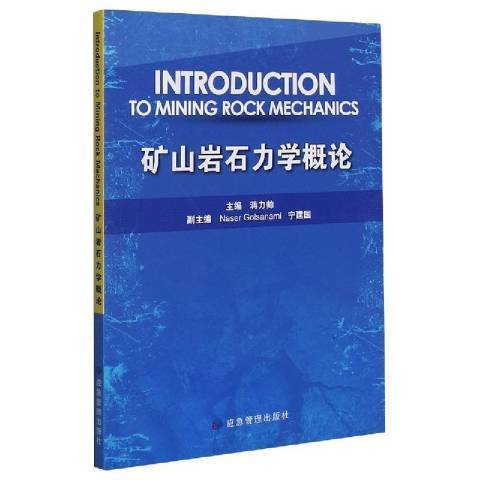內容簡介
岩石力學作為採礦工程專業學生的核心主幹課程,其教學內容的雙語化在採礦工程國際化人才培養中至關重要。《礦山岩石力學概論(英文版)》共分為七章,內容包括概述、岩體結構與特性、岩石強度與變形特性、原岩應力場及其測量、井巷工程設計、圍岩支護理論與技術、圍岩穩定性監測等。教材中重要單詞、短語分為“專業術語”和“常見用法”兩類,配以中文注釋,且每章設定課後習題,使讀者能夠掌握礦山岩石力學領域的專業英語辭彙,提高專業英語技能和表達能力。《礦山岩石力學概論(英文版)》即可作為高等院校採礦工程、岩土工程等相關專業本科生、研究生岩石力學課程的雙語教材使用,也可供從採礦工程等相關專業的科研、技術人員學習參考。
圖書目錄
Chapter 1 Rock mechanics in mining engineering礦山岩石力學概述
1.1 General concepts基本概念
1.2 Inherent complexities in rock mechanics岩石力學內在複雜性
1.2.1 Rock fracture
1.2.2 Scale effects
1.2.3 Tensile strength
1.2.4 Effect of groundwater
1.2.5 Weathering
1.3 Functional interactions in mine engineering礦山開採系統設計
1.3.1 Management
1.3.2 Geology
1.3.3 Planning
1.3.4 Rock mechanics
1.4 Application of rock mechanics in mining engineering岩石力學在採礦中的套用
1.4.1 Site characterization
1.4.2 Mine model formulation
1.4.3 Design analysis
1.4.4 Rock performance monitoring
1.4.5 Retrospective analysis
Exercises課後習題
Chapter 2 Rock mass structure and characterization岩體結構與特性
2.1 Introduction概述
2.2 Major types of structural features岩體結構特徵類型
2.3 Geomechanical properties of discontinuities 結構面力學特性
2.4 Rock mass classification岩體質量分級
2.4.1 The nature and use of rock mass classification schemes
2.4.2 Bieniawski’S geomechanics classification
2.4.3 The NGI Q system
2.4.4 Geological strength index(GSI)
Exercises課後習題
Chapter 3 Rock strength and deformability岩石強度與變形特性
3.I Introduction概述
3.2 Concepts and definitions相關概念和定義
3.3 Strength criteria for rock岩石強度理論
3.3.1 Types of strength criterion
3.3.2 Coulomb’S shear strength criterion
3.3.3 Griffith crack theory
3.3.4 Fracture mechanics
3.3.5 Empirical criteria
3.4 Behavior of discontinuous rock masses不連續岩體力學特性
Exercises課後習題
Chapter 4 Pre—mining state of stress原岩應力場
4.1 Introduction概述
4.2 Factors influencing the in—situ state of stress原岩應力場影響因素
4.2.1 Surface topography
4.2.2 Erosion and isostasy
4.2.3 Residual stress
4.2.4 Inclusions
4.2.5 Tectonic stress
4.2.6 Fracture sets and discontinuities
4.3 Methods of in—situ stress determination原岩應力場確定方法
Exercises課後習題
Chapter 5 Excavation in underground mining井巷工程
5.1 General principle of excavation design井巷設計原理
5.2 Zone of influence of an excavation開挖擾動區
5.3 Excavation design in stratified rock層狀圍岩開挖設計
5.3.1 Design factors
5.3.2 Rock mass response to mining
5.3.3 Roof bed deformation mechanics
5.4 Excavation design in blocky rock塊狀圍岩開挖設計
Exercises課後習題
Chapter 6 Rock support and reinforcement圍岩支護與加固
6.1 Terminology專業術語
6.2 Support and reinforcement principles支護加固原則
6.3 Support and reinforcement design支護加固設計
6.3.1 Purpose
6.3.2 Local support and reinforcement
6.3.3 General or systematic reinforcement
6.4 Support materials and techniques支護材料與技術
6.4.1 Rockbolts and dowels
6.4.2 Cable bolts
6.4.3 Shotcrete
6.4.4 Wire mesh
6.4.5 Steel sets
Exercises課後習題
Chapter 7 Rock mass stability monitoring圍岩穩定性監測
7.1 The purpose of rock mass stability monitoring 圍岩穩定監測目的
7.2 Monitoring systems監測系統
7.2.1 General features of monitoring systems
7.2.2 Modes of operation
7.2.3 Convergence measurement
7.2.4 Multiple—point borehole extensometers
7.2.5 Hydraulic pressure cells
7.2.6 Stress change measurements
7.2.7 Monitoring microseismic activity
7.2.8 Time domain reflectometry
Exercises課後習題
Reference參考文獻

